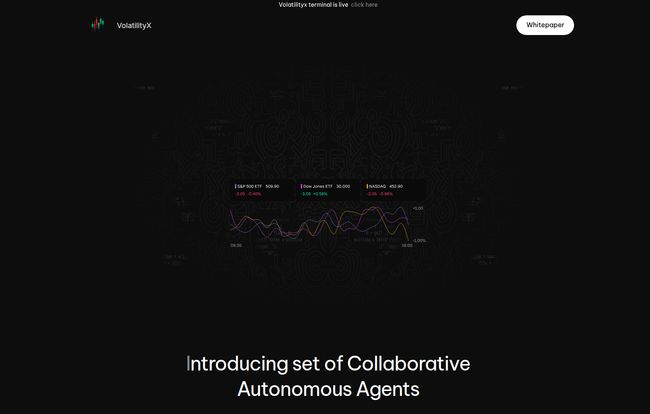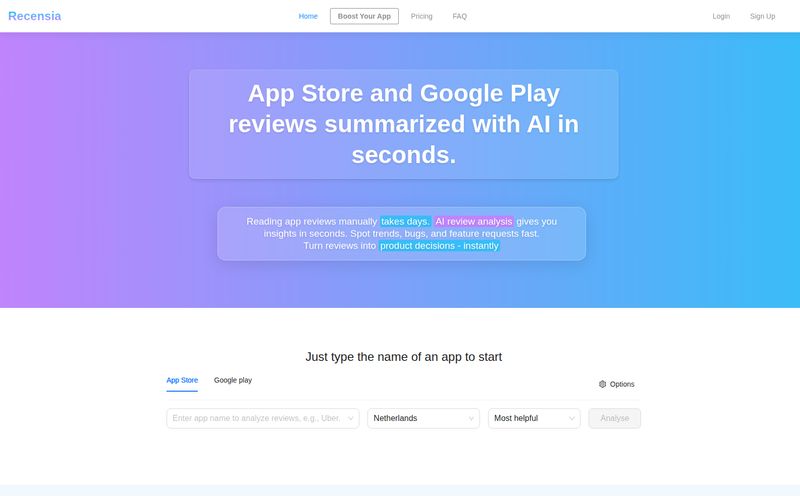If you're involved in the markets, your brain probably feels like a browser with 100 tabs open. You've got CNBC on in the background, a Twitter/X feed that never stops scrolling, a few Discord channels pinging, and you're trying to make sense of a candlestick chart that looks more like a modern art installation. It's a firehose of information, and most of it is just... noise. For years, the holy grail has been finding the signal in all that static.
I've seen dozens of platforms promise to deliver that signal. Some are great, some are just glorified stock screeners with a slick UI. So when I stumbled upon a new player called VolatilityX, my initial reaction was a healthy dose of professional skepticism. Its homepage greets you with a bold, almost sci-fi claim: "Introducing a set of Collaborative Autonomous Agents." Okay, you have my attention. Is this just marketing fluff, or is there something genuinely different under the hood? Let's take a look.
So, What is VolatilityX, Really?
Putting aside the fancy terminology for a second, VolatilityX positions itself as an "autonomous market ally." Think of it less like a charting tool and more like a team of tireless, data-obsessed research analysts that you don't have to pay overtime. The core idea is that a group of specialized AI agents are constantly scanning the markets for you. One agent might be an expert in options flow, another in scouring SEC filings, and a third in gauging market sentiment from social media. Together, they collaborate to give you a coherent picture of what's happening. It’s a pretty compelling concept, moving beyond a single algorithm to a whole team of them.
This isn't about predicting the future with a crystal ball. It’s about organizing the present so you can make a smarter decision about the future. It aims to deliver fact-based, data-driven intelligence without the emotional baggage or hidden agendas that often come with human analysis. For someone who has spent years analyzing traffic and trends, the idea of applying that same unbiased, data-first approach to my portfolio is… well, it’s appealing.

Visit VolatilityX
The Core Features: Your AI Research Team at Work
A tool is only as good as what it actually does. VolatilityX seems to be focused on a few key areas that are notoriously difficult and time-consuming for the average retail investor to track.
Real-Time Alerts That Actually Mean Something
We've all signed up for stock alerts that just tell you when a price hits a certain point. That's beginner stuff. VolatilityX is digging deeper. It's flagging things like unusual options flow and volume surges. Why does that matter? Well, in my experience, that's where you see the footprints of the big money. When a hedge fund or a big institution decides to make a move, they don't just buy a few shares. They move millions, often through complex options strategies. Seeing a sudden, massive spike in call option volume for a sleepy stock is like seeing a flare go up in the middle of the night. It doesn’t guarantee anything, but it certainly tells you where to look. It also keeps you updated on corporate releases, so you're not caught off guard by a surprise earnings pre-announcement or an important filing.
Going Deeper Than the Ticker Symbol
This is the part that really intrigues me. The platform promises "fundamental deep dives." That means its' AI agents will read through earnings reports, company information, and even track insider trades, then present you with the key takeaways. Anyone who has ever tried to read a 100-page 10-K filing at 7:00 AM knows what a godsend this could be. It's about saving time and getting straight to the point.
Then there's the sentiment analysis. This has become a huge factor in the post-GameStop market. How the internet feels about a stock can sometimes matter more than its P/E ratio. VolatilityX claims to analyze this sentiment, giving you a read on the crowd's mood. It's a qualitative metric that's notoriously hard to pin down, but incredibly powerful if you can get it right.
The Good, The Bad, and The AI-Driven
No platform is perfect, and my job is to be critical. What I genuinely like about the promise of VolatilityX is the democratization of data. For decades, this kind of real-time flow analysis and deep-dive data was locked behind terminals that cost a fortune, like the famed Bloomberg Terminal, which can run you over $25,000 a year. Making these insights accessible is a huge win for the little guy.
However, we have to talk about the caveats. Relying entirely on an AI, no matter how smart, can be a trap. These systems are only as good as their data and their algorithms. A bug or a misinterpretation of data could lead you down the wrong path. There's also the very real danger of information overload. If the platform is sending you alerts all day, are you really solving the "noise" problem, or are you just subscribing to a different, more sophisticated kind of noise? It's a fine line to walk. You still have to bring your own brain to the party; this is a tool for support, not a replacement for your own due diligence.
So, Who Is This Tool Really For?
I don't think this is for everyone. If you're a passive investor who just buys a broad market index fund every month and holds for 30 years, you can probably ignore this. But for others, it could be a game-changer.
- Active Day and Swing Traders: The real-time nature of the alerts on options flow and volume is tailor-made for you. This is your bread and butter.
- The 'Busy Professional' Investor: You have a career and a life, but you still manage your own portfolio. The AI-powered summaries of earnings reports and fundamentals could save you dozens of hours of research every quarter.
- The Data Nerd: If you love finding correlations and seeing how sentiment, fundamentals, and institutional flow interact, a platform like this is a massive sandbox to play in.
The Million-Dollar Question: What's the Price?
And here's where things get a bit mysterious. As of this writing, there's no public pricing information. The website mentions a "Whitepaper," which suggests its in an early phase, maybe a beta launch aimed at gathering feedback. In fact, some of the links on the site even lead to a 'Page Not Found' error, which tells me this is a project that is still very much in development. This isn't a bad thing! It just means we're getting an early look. I would speculate that they might go with a subscription model, perhaps with different tiers. But for now, we'll have to wait and see. It’s a classic startup move: build the hype, get the early adopters in, and figure out the monetization later.
Your Questions, Answered
Is VolatilityX a trading bot that buys and sells for me?
No, and that's an important distinction. It is an intelligence and analysis tool. It provides you with data and insights, but you are the one who has to pull the trigger on any trades. It's designed to make you smarter, not to trade for you.
Can I trust the AI's analysis 100% of the time?
I wouldn't recommend it. No tool is infallible. You should always treat AI-driven analysis as a powerful assistant. It can point you in the right direction and highlight things you might have missed, but it should be one component of your overall research process, not the entire thing.
What makes VolatilityX different from a tool like Finviz or other stock screeners?
Traditional screeners are mostly about filtering stocks based on set criteria (e.g., show me all tech stocks with a P/E under 20). VolatilityX appears to be more dynamic and interpretive, focusing on real-time events like options flow and providing narrative commentary and sentiment analysis, which is a step beyond simple filtering.
Is VolatilityX good for a complete beginner?
This is a tough one. On one hand, the summaries could simplify complex topics. On the other, data like "unusual options flow" can be misinterpreted without some foundational knowledge. I’d say it’s best for an intermediate investor, or a beginner who is highly motivated to learn.
Where can I sign up or get the whitepaper?
You can head over to their official website to check for the latest updates and access their whitepaper for a more technical breakdown of their system.
Final Thoughts: A Signal in the Static?
The financial world is overflowing with data, and VolatilityX is making a bold attempt to be the filter we all need. The idea of collaborative AI agents working as a personal research team is genuinely exciting and feels like a step in the right direction. It's not magic, and it won't make you a millionaire overnight. The success of a tool like this will hinge on the quality of its insights and its ability to not overwhelm the user.
It’s still early days, and the lack of pricing shows it's a platform that's still finding its feet. But I'm optimistic. In a world of loud opinions and conflicting advice, a tool that just wants to show you the data is a breath of fresh air. I’ll definitely be keeping VolatilityX on my radar and watching how it develops. It just might be the ally we need to navigate the beautiful chaos of the market.
Reference and Sources
- Official Website: VolatilityX
- Bloomberg Terminal Cost: Investopedia - What Is a Bloomberg Terminal and What Does It Cost?
- Market Sentiment Analysis: Sentix - What is Sentiment?



